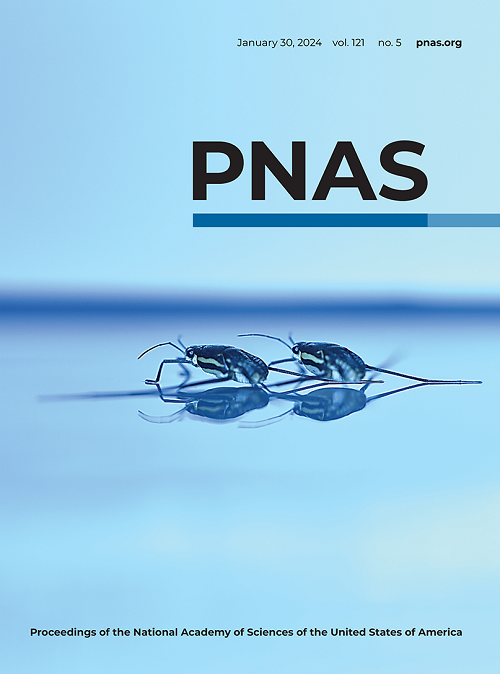Immobile lipopolysaccharides and outer membrane proteins differentially segregate in growing Escherichia coli
IF 9.4
1区 综合性期刊
Q1 MULTIDISCIPLINARY SCIENCES
Proceedings of the National Academy of Sciences of the United States of America
Pub Date : 2025-03-03
DOI:10.1073/pnas.2414725122
引用次数: 0
Abstract
The outer membrane (OM) of gram-negative bacteria is a robust, impermeable barrier that excludes many classes of antibiotics. Contrary to the classical model of an asymmetric lipid bilayer, recent evidence suggests the OM is predominantly an asymmetric proteolipid membrane (APLM). Outer leaflet lipopolysaccharides (LPS) that surround integral β-barrel outer membrane proteins (OMPs) are shared with other OMPs to form a supramolecular network in which the levels of OMPs approach those of LPS. Some of the most abundant OMPs in the固定的脂多糖和外膜蛋白在生长的大肠杆菌中差异分离
革兰氏阴性细菌的外膜(OM)是一道坚固的防渗屏障,可阻挡多种抗生素。与不对称脂质双分子层的经典模型相反,最近的证据表明外膜主要是不对称蛋白脂膜(APLM)。环绕着整体β管外膜蛋白(OMPs)的外叶脂多糖(LPS)与其他 OMPs 共享,形成一个超分子网络,其中 OMPs 的含量接近 LPS 的含量。大肠杆菌外膜蛋白中最丰富的一些外膜蛋白是三聚体孔蛋白。人们对孔蛋白和 LPS 如何融入生长中细菌的 OM 还知之甚少。在这里,我们利用活细胞成像和微流体技术研究了利用点击化学标记的 LPS 和利用细菌素 Colicin N 标记的孔蛋白 OmpF 如何结合到大肠杆菌的 OM 中。衍射极限荧光显微镜显示,OmpF 和 LPS 分布均匀且不移动。不过,通过超分辨率显微镜观察,这两种大分子的集群现象非常明显,它们的生物生成蛋白 BamA 和 LptD 也分别是这种情况。尽管存在这些共同的组织特征,但 OmpF 插入 OM 是细胞周期依赖性的,这导致了二元分割和旧 OmpF 的强烈极性积累。另一方面,旧的 LPS 在每个分裂周期都会被新的 LPS 稀释约 50%,导致先前存在的 LPS 只有轻微的极性积累。我们的结论是,虽然 LPS 和 OMPs 注定要形成 APLM,但它们的插入动力学却有本质区别,这对理解 OM 是如何组装的具有重要意义。
本文章由计算机程序翻译,如有差异,请以英文原文为准。
求助全文
约1分钟内获得全文
求助全文
来源期刊
CiteScore
19.00
自引率
0.90%
发文量
3575
审稿时长
2.5 months
期刊介绍:
The Proceedings of the National Academy of Sciences (PNAS), a peer-reviewed journal of the National Academy of Sciences (NAS), serves as an authoritative source for high-impact, original research across the biological, physical, and social sciences. With a global scope, the journal welcomes submissions from researchers worldwide, making it an inclusive platform for advancing scientific knowledge.

 求助内容:
求助内容: 应助结果提醒方式:
应助结果提醒方式:


